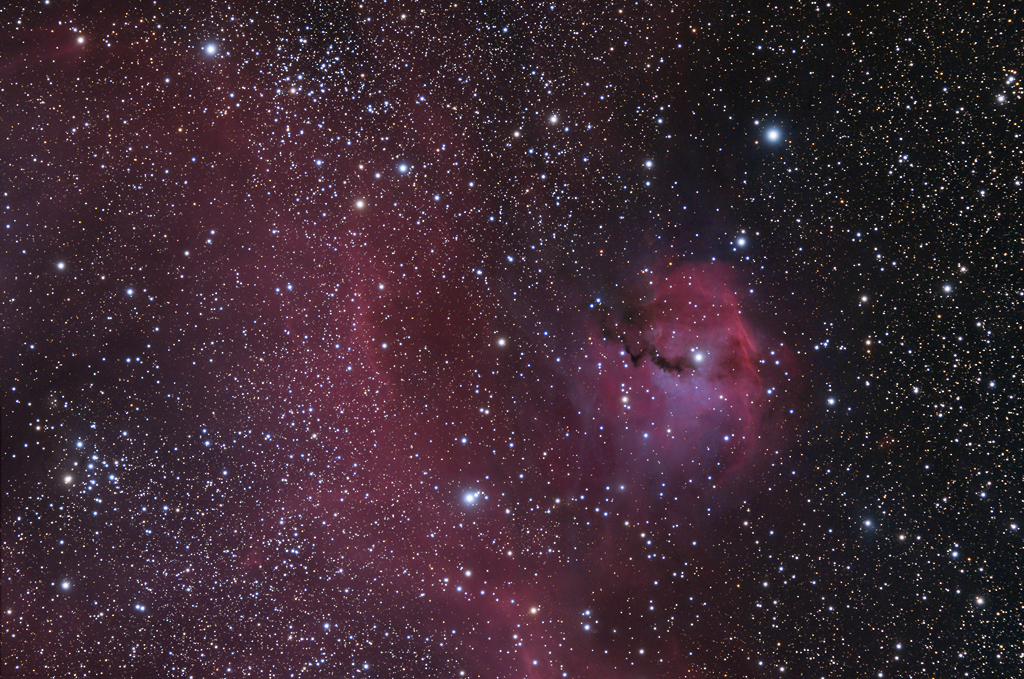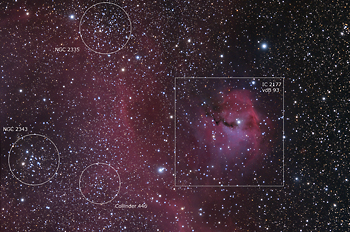 |
CHAMÄLEON + ONJALA OBSERVATORY DeepSky | SITEMAP HOME CHAMÄLEON |
|
 |
|||
| « zurück zur Startseite
galaktische Nebel « back to home galactic nebula |
Großes Bild laden - load large
image 2048 x
1400 Pixel Aufnahmedaten Image data |
IC 2177 - the head of the seagull, emission and reflection in the constellation Unicorn (Monoceros)

IC 2177 ist das Zentrum einer großen H-II Sternentstehungsregion, vermischt mit blauen Reflexionsnebeln. Es handelt sich dabei um eine annähernd kreisförmige Struktur, ungefähr zentriert um den Be Stern HD 5336. Aufgrund seiner groben Formgebung wird er auch Möwennebel genannt. In der Bildorientierung unserer Weitwinkelansicht fliegt die Möwe in Richtung zum unteren Bildrand, wobei die annähernd runde Nebelstruktur unterhalb der Flügel dem Kopf der Möwe entspricht.
Der helle "Kopf der Möwe", IC 2177, ist auch als GUM 1, Sh2-292 und vdB 93 klassifiziert und es ist eine Mischung aus Reflexions- und Emissionsnebeln. Der heiße, junge B0 Stern HD 53367 ist die Quelle für die Emissionsanregung. HD 53367 ist 20 mal so massereich wie unsere Sonne mit einem Begleiter mit 5 Sonnenmassen, der den Hauptstern auf einer stark elliptischen Umlaufbahn umkreist.
Der gesamte Möwennebel ist Teil der Majoris OB1 Assoziation und steht in einer Entfernung von ca. 3750 Lichtjahren zum Sonnensystem. IC 2177 liegt entlang der Grenze zwischen den Sternbildern Monoceros und Canis Major.
Weiter zeigt unser Bild die beiden hellen, offenen Sternhaufen NGC 2343 und NGC 2335. NGC 2343 ist ein offener Sternhaufen und hat einen scheinbaren Durchmesser von 6 Bogenminuten, visuell sind etwa 20 Sterne beobachtbar. Nach Trumpler wird er als Typ III 3 p n klassifiziert, die Entfernung zum Sonnensystem wird auf 3.400 Lichtjahre geschätzt. Entdeckt wurde NGC 2343 am 10. Januar 1785 von Friedrich Wilhelm Herschel. NGC 2335 ist ebenfalls ein offener Sternhaufen im Sternbild Einhorn. Nach Trumpler wird er als Typ III 3 m klassifiziert, visuell sind ca. 35 Sterne sichtbar. Die Entfernung zum Sonnensystem beträgt ungefähr 4.500 Lichtjahre. Entdeckt wurde der Sternhaufen am 10. Januar 1785 von Friedrich Wilhelm Herschel.
Object description
IC 7177 is the center of a large H-II star forming region, mixed with blue reflection nebulae. It is an approximately circular structure, roughly centered around the Be star HD 5336. Because of its rough shape it is also called the Seagull Nebula. In the image orientation of our wide-angle view, the seagull flies toward the bottom of the image, with the approximately circular nebular structure below the wings corresponding to the head of the seagull.
The bright "head of the gull," IC 2177, is also classified as GUM 1, Sh2-292, and vdB 93, and it is a mixture of reflection and emission nebulae. The hot, young B0 star HD 53367 is the source of the emission excitation. HD 53367 is 20 times as massive as our Sun with a 5 solar mass companion orbiting the main star in a highly elliptical orbit
The entire Gull Nebula is part of the Majoris OB1 association and stands at a distance of about 3750 light years from the solar system. IC 2177 lies along the boundary between the constellations Monoceros and Canis Major.
 |
Further our image shows the two bright open star clusters
NGC 2343 and NGC 2335. NGC 2343 is an open star
cluster in the constellation Unicorn (Monoceros). It has an apparent diameter
of 6 arcminutes, visually about 20 stars are observable. According to Trumpler
it is classified as type III 3 p n, the distance
to the solar system is estimated to 3,400 light-years. NGC 2343 was discovered
by Friedrich Wilhelm Herschel on January 10, 1785. NGC
2335 is also an open star cluster in the constellation Unicorn.
According to Trumpler it is classified as type III 3 m, visually about 35 stars
are visible. The distance to the solar system is about 4,500 light-years. The
star cluster was discovered by Friedrich Wilhelm Herschel on January 10, 1785.
« Klicken Sie hier oder auf das Vorschaubild zum Laden eines großen Bildes mit Objektbezeichnungen. « « Click here or on the thumbnail to load a large image with object annotations. |
IC 2177 - the head of the seagull, emission and reflection in the constellation Unicorn (Monoceros)
Image data
19.+20.+22.04.2022 - 24 x 600 s, ZWO ASI 071 Pro - Color (cooled)
Telescope: Astro Physics 130mm EDFS + Flattener at f = 850mm
Location: Chamäleon Observatory, Onjala Lodge, Namibia
Image acquisition and processing: DeepSkyStacker, PixInsight + Photoshop
 |
 |
 |
 |
 |
 |
 |
| Sonne | Mond | Sonnensystem | DeepSky | Weitwinkel | Verschiedenes | Spez. Projekte |